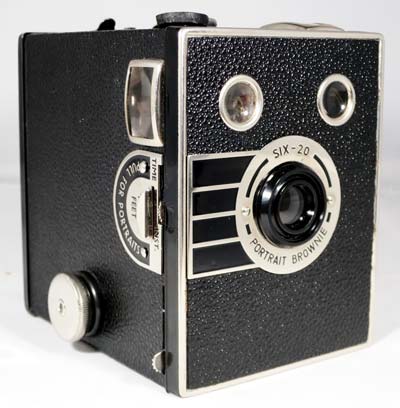Kodak Six-20 Portrait Brownie
Specification

| Manufacturer | : | Kodak |
|---|---|---|
| Produced | : | 1936 - 1940 |
| Classification | : | Medium Format |
| Body Type | : | Box |
| Construction | : | Metal |
| Film Type | : | 620 |
| Film Width | : | 62mm |
| Image Size | : | 2¼ x 3¼ in |
| No. of Images | : | 8 |
| Lens Type | : | Meniscus |
| Focus Type | : | Fixed + Portrait Lens |
| Focal Length | : | 95mm |
| Focus Range | : | 6ft to inf. 4-6ft with Portrait lens |
| Aperture Type | : | Fixed |
| Aperture | : | f/11 |
| Shutter Type | : | Rotary |
| Shutter Speeds | : | B,I*(1/45 sec) |
| Size (w x h x d) | : | 84 x 105 x 105 mm |
| Weight | : | 475g |
| * Measured on this camera | ||
Art Deco Credentials
![]()
![]()
![]()
Noteworthy: Worth giving special attention
- Produced during the main Art Deco period;
- Geometric Art Deco front lens bezel;
- Chrome and black enamel front lens bezel;
- Chrome and black enamel panel for side controls;
- Chrome winder, rear door latch and strap posts;
- Chrome finder surrounds.
Description
The Kodak Six-20 Portrait Brownie is a box-type camera from the mid 1930s. The Art Deco front bezel meets a matching side bezel for the shutter lever and other controls. The body is metal and covered in leatherette. The leatherette is used for the film door hinge. It has two reflecting brilliant finders. It has a portrait lens covering 4-6 feet which is activated by pulling a tab. It has a genuine leather handle. There is no tripod mount. It is also almost identical to the Kodak Brownie Senior camera.
How to Use
This camera takes 620 film which is still available from selected photographic outlets. Although the actual film is the same as 120 film, the spools are different. The 620 spools are slightly shorter and have a smaller diameter. Do not use 120 film in this camera because it will jam and may snap. It is possible to cut down a spool of 120 film to fit or to re-spool some 120 film onto 620 spools in a darkroom or changing bag.
Don't forget to ask for your 620 spool back when getting the film developed.
The shutter speed for this particular camera was measured at 1/40s for the downward movement of the shutter lever and 1/50s for the upward movement. The average was 1/45s. At this speed it is advisable to use a tripod to get clear shake free images. However, holding it against a wall or other solid object would work as well. For quick snapshots, hold it firmly against your body.
If you don't want to bother with an exposure meter, follow the guide shown. It is based on the 'Sunny 16' rule. Film is so forgiving and will produce acceptable results even when overexposed by 2 or 3 stops or underexposed by 1 stop.
The tables assume that the sun is at least 30 degrees above the horizon - that's 10am - 5pm on a summers day (May - August) in the UK.
Remember that the exposure guide in the manual may not be helpful as it is based on the use of old film with a low ISO value.
Using ISO 100/125 film - shutter speed 1/45s
| Weather Conditions | Shadow Detail | Aperture | Exposure |
|---|---|---|---|
 Sunny SunnySnow/Sand | Dark with sharp edges | f/11 | +3 Stops Overexposed Acceptable |
 Sunny Sunny | Distinct | f/11 | +2 Stops Overexposed Acceptable |
 Slight Overcast Slight Overcast | Soft around edges | f/11 | +1 Stop Overexposed Acceptable |
 Overcast Overcast | Barely visible | f/11 | Good |
 Heavy Overcast Heavy Overcast | None | f/11 | -1 Stop Underexposed Acceptable |
 Open Shade Open Shade/Sunset | None | f/11 | -2 Stops Underexposed Not Acceptable |